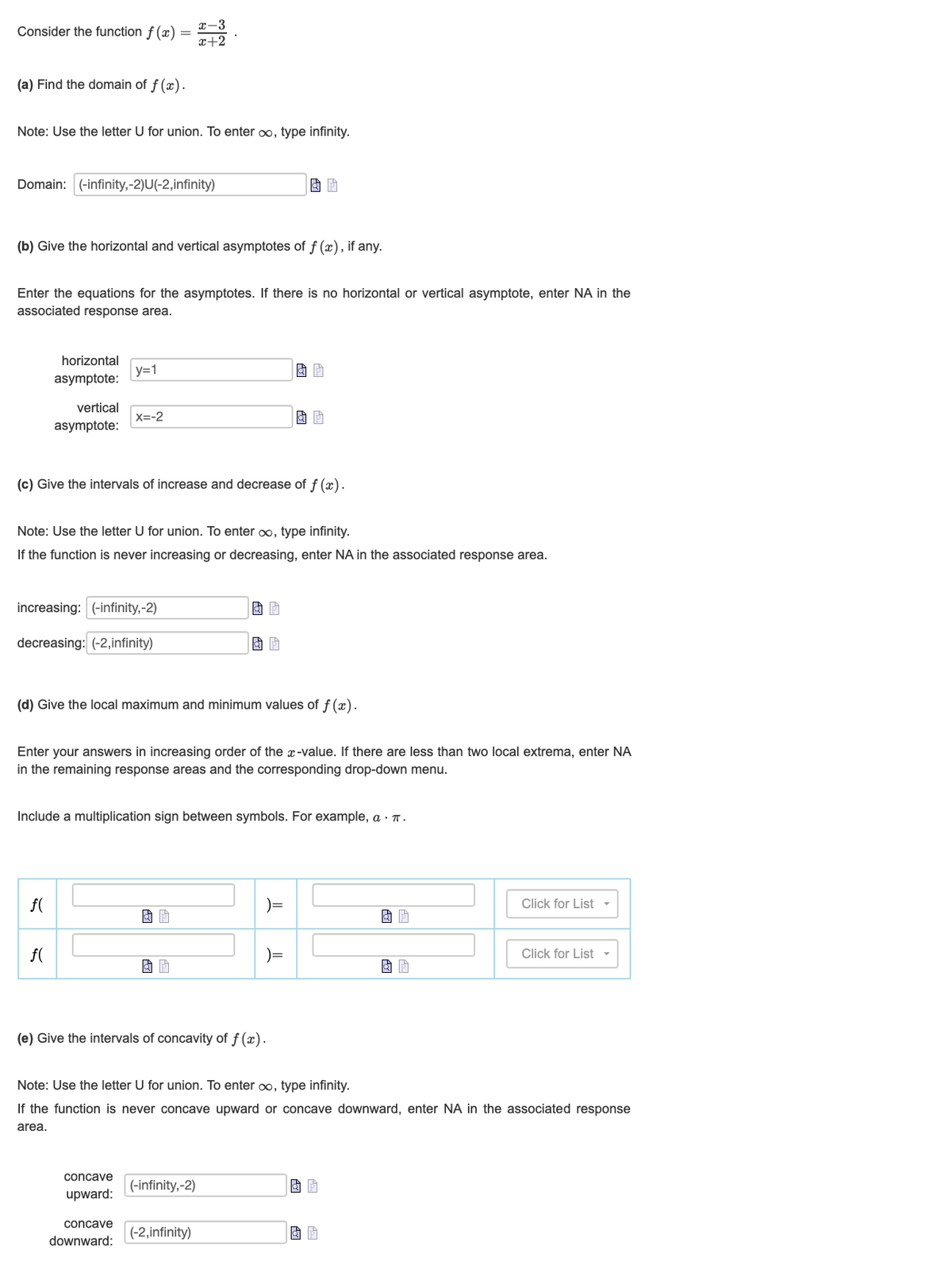Consider the function f(x) = (a) Find the domain of f(x). Note: Use the letter U for union. To enter ∞o, type infinity. Domain: (-infinity,-2)U(-2,infinity) (b) Give the horizontal and vertical asymptotes of f (x), if any. Enter the equations for the asymptotes. If there is no horizontal or vertical asymptote, enter NA in the associated response area. horizontal asymptote: vertical asymptote: x+2 y=1 (d) Give local X=-2 (c) Give the intervals of increase and decrease of f(x). increasing: (-infinity,-2) decreasing: (-2,infinity) f( Note: Use the letter U for union. To enter oo, type infinity. If the function is never increasing or decreasing, enter NA in the associated response area. f( 团团 & P Enter your answers in increasing order of the x-value. If there are less than two local extrema, enter NA in the remaining response areas and the corresponding drop-down menu. and minimum values of f(x). Include a multiplication sign between symbols. For example, a .. )= )= & P Click for List - Click for List
Consider the function f(x) = (a) Find the domain of f(x). Note: Use the letter U for union. To enter ∞o, type infinity. Domain: (-infinity,-2)U(-2,infinity) (b) Give the horizontal and vertical asymptotes of f (x), if any. Enter the equations for the asymptotes. If there is no horizontal or vertical asymptote, enter NA in the associated response area. horizontal asymptote: vertical asymptote: x+2 y=1 (d) Give local X=-2 (c) Give the intervals of increase and decrease of f(x). increasing: (-infinity,-2) decreasing: (-2,infinity) f( Note: Use the letter U for union. To enter oo, type infinity. If the function is never increasing or decreasing, enter NA in the associated response area. f( 团团 & P Enter your answers in increasing order of the x-value. If there are less than two local extrema, enter NA in the remaining response areas and the corresponding drop-down menu. and minimum values of f(x). Include a multiplication sign between symbols. For example, a .. )= )= & P Click for List - Click for List
Algebra & Trigonometry with Analytic Geometry
13th Edition
ISBN:9781133382119
Author:Swokowski
Publisher:Swokowski
Chapter4: Polynomial And Rational Functions
Section4.5: Rational Functions
Problem 54E
Related questions
Question

Transcribed Image Text:Consider the function f(x):
(a) Find the domain of f(x).
Note: Use the letter U for union. To enter oo, type infinity.
Domain: (-infinity,-2)U(-2,infinity)
(b) Give the horizontal and vertical asymptotes of f (x), if any.
Enter the equations for the asymptotes. If there is no horizontal or vertical asymptote, enter NA in the
associated response area.
horizontal
asymptote:
vertical
asymptote:
y=1
(c) Give the intervals of increase and decrease of f(x).
increasing: (-infinity,-2)
decreasing: (-2,infinity)
f(
X=-2
Note: Use the letter U for union. To enter oo, type infinity.
If the function is never increasing or decreasing, enter NA in the associated response area.
f(
x-3
x+2
(d) Give the local maximum and minimum values of f(x).
Enter your answers in increasing order of the x-value. If there are less than two local extrema, enter NA
in the remaining response areas and the corresponding drop-down menu.
Include a multiplication sign between symbols. For example, a . π.
concave
upward:
concave
downward:
& P
& P
(e) Give the intervals of concavity of f(x).
(-infinity,-2)
(-2,infinity)
II
II
Note: Use the letter U for union. To enter oo, type infinity.
If the function is never concave upward or concave downward, enter NA in the associated response
area.
Click for List
& P
Click for List -
Expert Solution
This question has been solved!
Explore an expertly crafted, step-by-step solution for a thorough understanding of key concepts.
Step by step
Solved in 5 steps with 4 images

Follow-up Questions
Read through expert solutions to related follow-up questions below.
Follow-up Question
I appreciate your assistance but the questions you answered were already completed. I need help with (d) & (f)
d-
f- Inflection points of f(x)
Solution
Recommended textbooks for you

Algebra & Trigonometry with Analytic Geometry
Algebra
ISBN:
9781133382119
Author:
Swokowski
Publisher:
Cengage

College Algebra (MindTap Course List)
Algebra
ISBN:
9781305652231
Author:
R. David Gustafson, Jeff Hughes
Publisher:
Cengage Learning

Algebra and Trigonometry (MindTap Course List)
Algebra
ISBN:
9781305071742
Author:
James Stewart, Lothar Redlin, Saleem Watson
Publisher:
Cengage Learning

Algebra & Trigonometry with Analytic Geometry
Algebra
ISBN:
9781133382119
Author:
Swokowski
Publisher:
Cengage

College Algebra (MindTap Course List)
Algebra
ISBN:
9781305652231
Author:
R. David Gustafson, Jeff Hughes
Publisher:
Cengage Learning

Algebra and Trigonometry (MindTap Course List)
Algebra
ISBN:
9781305071742
Author:
James Stewart, Lothar Redlin, Saleem Watson
Publisher:
Cengage Learning

College Algebra
Algebra
ISBN:
9781305115545
Author:
James Stewart, Lothar Redlin, Saleem Watson
Publisher:
Cengage Learning
